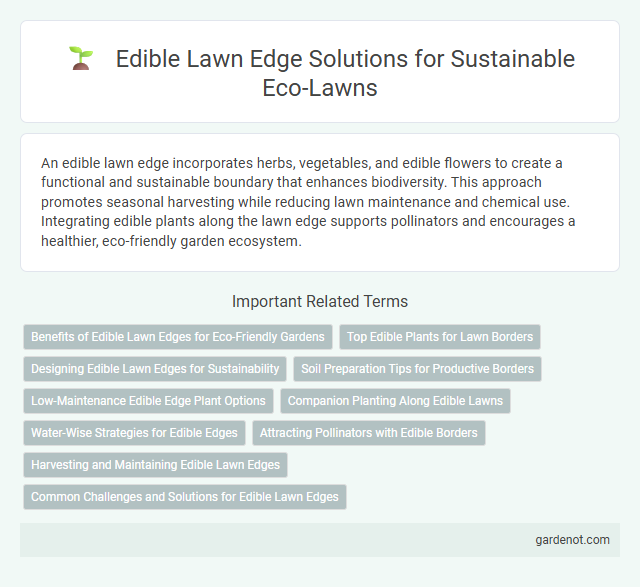An edible lawn edge incorporates herbs, vegetables, and edible flowers to create a functional and sustainable boundary that enhances biodiversity. This approach promotes seasonal harvesting while reducing lawn maintenance and chemical use. Integrating edible plants along the lawn edge supports pollinators and encourages a healthier, eco-friendly garden ecosystem.
Benefits of Edible Lawn Edges for Eco-Friendly Gardens
Edible lawn edges promote biodiversity by attracting pollinators like bees and butterflies, enhancing overall garden health while providing a sustainable food source. These plants reduce the need for chemical fertilizers and pesticides, supporting eco-friendly gardening practices and improving soil quality. Integrating herbs and vegetables along lawn borders maximizes space efficiency and encourages natural pest control through companion planting.
Top Edible Plants for Lawn Borders
Top edible plants for lawn borders include herbs like thyme, chives, and oregano, which are low-growing, drought-tolerant, and attract pollinators. Edible flowers such as nasturtiums and pansies provide both aesthetic appeal and culinary use, thriving in sunny lawn edges. Berry-producing shrubs like low-growing currants or alpine strawberries offer seasonal fruit while maintaining a neat, eco-friendly lawn boundary.
Designing Edible Lawn Edges for Sustainability
Designing edible lawn edges enhances sustainability by integrating nutrient-rich plants that support local ecosystems and reduce water consumption. Utilizing native herbs, vegetables, and flowers as lawn borders improves biodiversity, attracts pollinators, and provides fresh food sources without chemical inputs. Incorporating permeable materials and efficient irrigation methods further minimizes environmental impact while promoting soil health.
Soil Preparation Tips for Productive Borders
Soil preparation for an edible lawn edge begins with thorough soil testing to determine pH and nutrient levels, ensuring optimal conditions for plant growth. Incorporate organic compost and well-rotted manure to enhance soil structure, drainage, and fertility, promoting healthy roots for productive borders. Regularly loosen the soil to prevent compaction and improve aeration, supporting robust growth of edible plants along the lawn edge.
Low-Maintenance Edible Edge Plant Options
Low-maintenance edible lawn edge plants such as thyme, creeping rosemary, and chamomile create a flavorful and sustainable boundary that requires minimal watering and mowing. These hardy herbs tolerate foot traffic while enriching soil health and attracting pollinators like bees and butterflies. Incorporating such edible edges transforms traditional lawn borders into productive, eco-friendly spaces that conserve resources and enhance biodiversity.
Companion Planting Along Edible Lawns
Edible lawn edges enhance biodiversity by incorporating companion plants such as herbs, flowers, and vegetables that support the health and growth of adjacent edible lawns. These companion plants naturally deter pests, improve soil fertility, and attract beneficial pollinators, creating a thriving, low-maintenance ecosystem. Selecting compatible species like marigolds, chives, and nasturtiums ensures optimal plant synergy and maximizes yield along edible lawn borders.
Water-Wise Strategies for Edible Edges
Edible lawn edges incorporate drought-resistant plants such as rosemary, thyme, and sage that thrive on minimal water, optimizing water usage in garden design. Implementing drip irrigation systems and mulching techniques reduces evaporation and conserves soil moisture for these edible borders. Strategic planting of native, water-wise herbs supports sustainable landscaping by enhancing biodiversity and reducing water waste.
Attracting Pollinators with Edible Borders
Edible lawn edges featuring flowering herbs and native plants create vibrant habitats that attract essential pollinators like bees, butterflies, and hummingbirds. Incorporating species such as lavender, thyme, and ornamental strawberries enhances biodiversity and supports local ecosystems. These living borders not only provide visual interest but also promote environmental sustainability through natural pollination services.
Harvesting and Maintaining Edible Lawn Edges
Harvesting edible lawn edges involves regularly picking herbs, edible flowers, and low-growing vegetables to encourage continuous growth and prevent overgrowth. Maintaining these zones requires consistent watering, mulching to retain moisture, and trimming to control invasive weeds and pests naturally. Proper care enhances soil health and ensures a sustainable, productive edible lawn edge.
Common Challenges and Solutions for Edible Lawn Edges
Edible lawn edges face challenges such as inconsistent growth, pest infestations, and soil nutrient competition with adjacent grass. Implementing drip irrigation systems ensures even moisture, while introducing natural pest repellents like neem oil reduces damage without chemicals. Regular soil testing and amending with organic compost improve nutrient balance, promoting healthier growth for both edible plants and lawn grass.
Edible lawn edge Infographic

 gardenot.com
gardenot.com